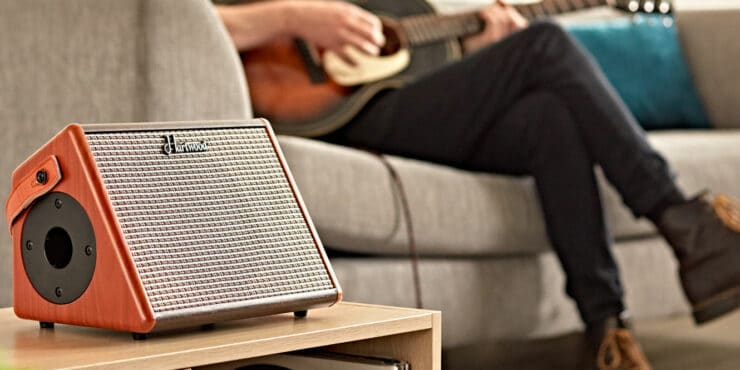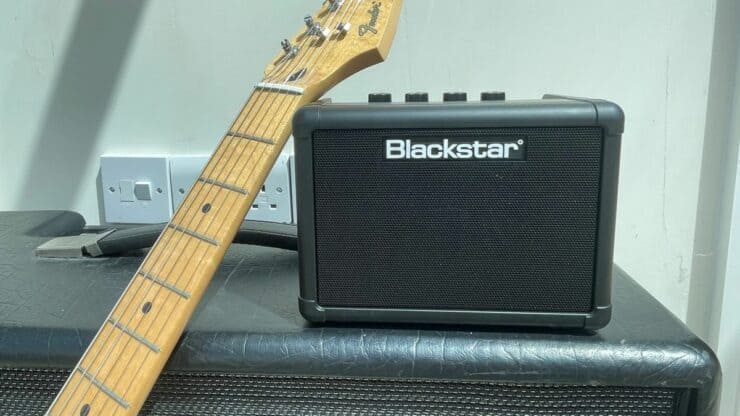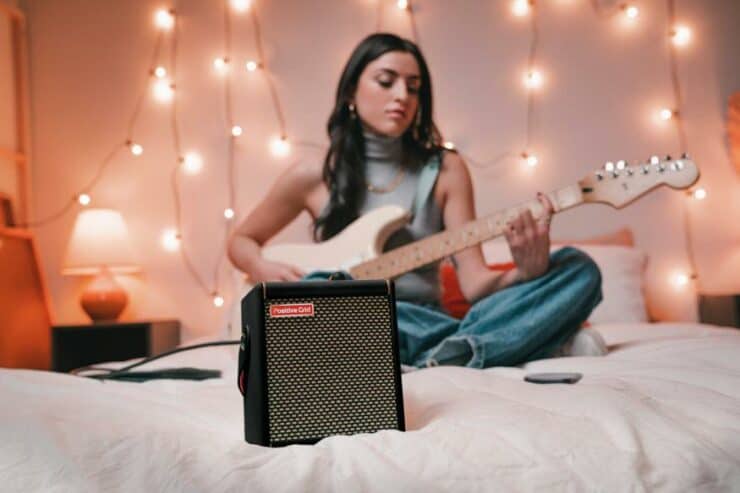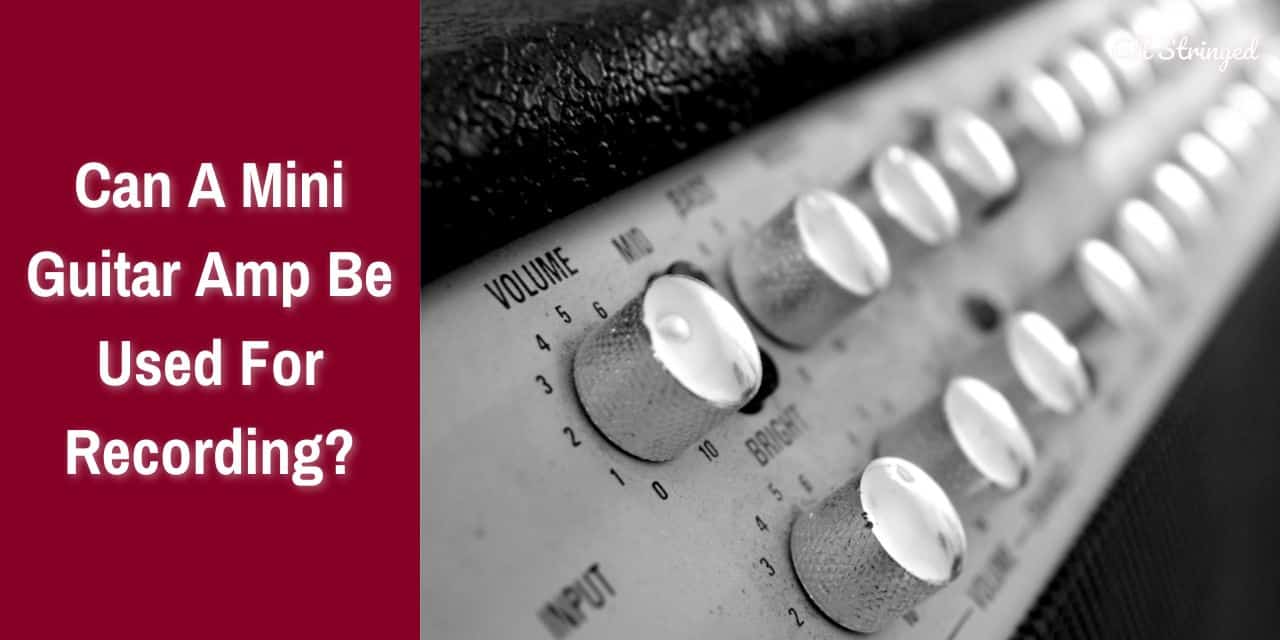Are you a guitar player looking to record your music but don’t want to break the bank? Mini guitar amps are an affordable and convenient way to get started with recording. In this article, we’ll explore how mini guitar amps can be used in your recording process and the pros and cons of doing so. If you’re ready to learn more, read on!
What does a mini guitar amp do?
For musicians and guitarists who value portability and versatility, mini guitar amps have become an important piece of equipment. These compact amps offer a wide range of benefits, making them a popular option among musicians of all levels.
A mini guitar amp is a compact amp designed specifically for electric guitars. It is smaller in size compared to standard amps and often runs on batteries or has a built-in rechargeable power source. Mini guitar amps are typically lightweight and quite easy to carry, which makes them ideal for practice sessions, small gigs, travel, and on-the-go performances.
>>> Click here to read our review about the Top 15 Best Mini Guitar Amps <<<
A mini guitar amp comes in handy in a wide variety of aspects such as practice and home use, live performances, portability features, and more.
One of the biggest areas where mini guitar amps thrive is providing an amp option that is extremely portable. These amps are lightweight, compact, and easy to transport, allowing you to practice or perform anywhere, whether it is their backyard, living room, or even while traveling. Mini guitar amps are a convenient option for musicians looking for a portable setup without compromising on sound quality.
Mini guitar amps are also perfect for practice sessions at home. Their compact size will allow for easy setup in small spaces, such as bedrooms or apartments, where larger amps might not be practical. They often come with headphone jacks, allowing for private practice without disturbing others. Some models also come with auxiliary inputs, enabling musicians and guitarists to play along with backing tracks or songs from external devices.
Despite their small size, these amps offer a surprising range of tones and effects. Many mini amp models feature built-in distortion, reverb, and other effects, allowing musicians and guitarists to experiment with different sounds. Some also have multiple amp modeling options, replicating the sound characteristics of famous amp models. This versatility makes mini guitar amps ideal for various musical genres and playing styles.
While mini guitar amps are primarily designed for practice and small gigs, they can also be useful during live performances. They are especially useful in intimate venues or acoustic settings where a full-sized amp might be excessive. With a mini guitar amp, musicians will be able to easily amplify their sound, control their tone, and be ready to perform on stage with minimal setup time and effort.
Mini guitar amps are an amazing tool for recording and studio work. Their compact size will allow them to be placed directly in front of microphones, capturing their unique tones accurately. They can be used as an alternative to bulky amps in home studios, providing convenience and versatility for recording guitar tracks or adding effects to recordings.

Can a mini guitar amp be used for recording?
As a musician or guitarist, it is common to wonder can a mini guitar amp be used for recording. The simple answer to that is yes, a mini guitar amp can be used for recording. All you need to do is place a microphone in front and capture the tone. However, some amps manage to shine more than others in the recording booth.
Now, many people might think the bigger the amp, the bigger the tone when you are recording. However, in reality, unless you’ve got the appropriate soundproofing in your studio or home, you will not struggle to get the mini guitar amp loud enough to properly capture its true tone.
As surprising as it may sound, legends like Jimmy Page, Mike Campbell, and Bonamassa used to employ mini guitar amps for achieving massive tones. The reason was that mini guitar amps can be easily pushed to the limit despite not having excessive volume. This makes them the perfect option for recording.
Advantages of using a mini guitar amp for recording
When it comes to recording guitar tracks, having the right equipment will be important for achieving the desired sound. While full-sized guitar amps are often the go-to option for recording, using a mini guitar amp can bring a range of advantages that make it a viable option for recording sessions. Here are some of the advantages of using a mini guitar amp for recording and how it can enhance your recording experience.
#1. Portability and convenience
One of the biggest advantages of using a mini guitar amp for recording is its portability and convenience. Mini guitar amps are compact and lightweight, which makes them easy to transport and set up in different recording environments.
Whether you are recording in a professional studio or a home setup, a mini guitar amp will allow you to position it precisely where you need it, ensuring optimal microphone placement and ease of access to control settings.
#2. Direct mic placement
Mini guitar amps are small enough to be placed close to the mic, allowing for direct mic placement. This proximity captures the unique tonal characteristics and nuances of the amp, resulting in a more accurate representation of its sound. Direct mic placement will minimize unwanted room reflections and enhance the clarity and definition of the recorded guitar tracks.
#3. Versatile tonal options
Despite their smaller size, many guitar amps offer a wide variety of tonal options and built-in effects. These amps often come equipped with different amp models, emulating the sound characteristics of renowned amplifiers.
Some of them also come with built-in effects like reverb, distortion, and modulation, allowing you to experiment with different tones and textures during recording sessions. This versatility will help you achieve a wide range of sounds without the need for additional gear or plugins.
#4. Control and flexibility
Many mini guitar amps provide control over your guitar tone during recording. They typically come with dedicated knobs for adjusting parameters such as gain, volume, tone, and effects. This level of control will allow you to tailor the sound to fit your specific recording needs, whether you are aiming for a clean and polished tone or a gritty and distorted texture. With a mini guitar amp, you’ll get the flexibility to shape your tone directly at the source, saving time during the mixing and post-production stages.
#5. Noise and distortion control
Mini guitar amps often offer effective noise-reduction features that help minimize unwanted hums, buzzes, and interferences. These amps are designed for providing clean and quiet signal paths, ensuring that your recorded tracks are free from unwanted background noise.
Additionally, mini guitar amps will allow you to control the level of distortion and saturation, allowing you to achieve the desired level of crunch or overdrive without compromising the overall clarity of the recording.

#6. Cost-effective solution
Using a mini guitar amp for recording can be a rather cost-effective solution, especially for home studio setups. Compared to large amps, mini guitar amps are generally more affordable, which makes them accessible to musicians on a budget. They provide an affordable way of capturing quality guitar tones without the need for extensive microphone setups or costly studio gear.
Disadvantages of using a mini guitar amp for recording
While mini guitar amps offer numerous advantages for recording guitar tracks, it is also important to acknowledge that they might come with certain limitations or disadvantages. Understanding these drawbacks will help you make a smarter decision when choosing the equipment for your recording sessions. Here are some of the primary disadvantages of using a mini guitar amp for recording.
#1. Limited power and headroom
One of the primary limitations of mini guitar amps is their reduced power and headroom compared to larger amps. Due to their compact size, mini guitar amps often come with lower wattage ratings, which can result in a lack of overall volume and dynamic range. This can be especially noticeable when recording music genres that need high-gain tones or when trying to achieve maximum sonic impact.
#2. Reduced speaker size and tone protection
Mini guitar amps typically come equipped with smaller speakers, which can affect the overall tone and projection of the recording smaller speakers. This can affect the overall tone and projection of the recorded guitar tracks.
The smaller speaker size might result in less depth and presence, making it challenging to capture a full-bodied and rich guitar sound. While microphone placement and post-production techniques can mitigate this limitation to an extent, it is important to consider the potential tonal limitations of mini guitar amps when recording.
#3. Limited sound shaping options
Although mini guitar amps offer a wide range of tonal options and built-in effects, their control layouts and parameter options can be more limited compared to larger amps. This can restrict your ability to fine-tune the sound precisely to your liking during the recording process. Adjustments for EQ, gain, and other tonal characteristics might have a limited range, reducing the versatility and control over your guitar tone.
#4. Limited connectivity and integration
Mini guitar amps might have limited connectivity options, especially when it comes to external recording gear and interfaces. They might sometimes lack dedicated line outputs or direct recording capabilities, making it challenging to integrate them seamlessly into your recording setup. This limitation will require additional adapters or signal routing solutions to connect the mini guitar amp to your recording equipment effectively.
#5. Potential compromise in sound quality
While mini guitar amps offer decent sound quality, they might not match the sonic characteristics and fidelity of larger, high-end amps. The smaller size and reduced component quality in some models might result in a compromise in overall sound quality, especially when compared to high-end tube amps or professional studio setups. This limitation might be more noticeable in critical listening or when aiming for pristine, studio-quality recordings.
#6. Limited customization options
Mini guitar amps are generally designed as standalone units with limited expandability options. Unlike larger amps, they might not support additional speaker cabinets, external effects loops, or other customization options that enhance your recording possibilities. This limitation can restrict your ability to tailor the sound to specific recording scenarios or to experiment with different setups and configurations.
How to record with a mini guitar amp?
Recording guitar tracks with a mini guitar amp can be an extremely convenient and efficient way of capturing your unique sound. While the process might vary depending on the specific amp and recording equipment you are using, there are a number of steps you should follow for a successful recording session. Here are the steps you need to follow for recording with a mini guitar amp.
Step 1: Set up your mini guitar amp
First, you should look for a suitable recording environment. Choose a quiet room or space where you can set up your mini guitar amp without any unwanted background noise or distractions. After that, place your mini guitar amp in a location where it can be easily accessed for adjustments and mic placement. Consider the acoustics of the room and experiment with amp placement to achieve the desired sound.
Now, you should connect the power source to your mini guitar amp. Depending on the amp model, it might run on batteries or require an AC power adapter. Make sure that the amp is receiving the appropriate power supply. Plug your guitar into the input jack of the mini guitar amp using a suitable instrument cable.
Step 2: Connect the amp to a recording device
First, you should select your recording device. Decide upon the recording device that you will be using. It can range from a digital audio interface connected to your PC to a standalone multitrack recorder.
After that, connect the output of the mini amp. Depending on the available options on your mini guitar amp, you can connect the output directly to the recording device using an instrument cable. Some mini guitar amps might have a dedicated line output while others may need a headphone output or emulated output. Make use of the appropriate cables and adapters as needed.
Then, you should adjust the recording device settings. Set the recording device to receive the signal from the mini guitar amp. Consult the owner’s manual of your recording device for specific instructions on setting the input levels and choosing the appropriate input source.

Step 3: Adjust the amp settings
Start by setting the amp’s volume to a reasonable level for recording. You should adjust the master volume or gain control for achieving a balanced signal without clipping or distortion. Remember that you can always adjust the overall volume during the mixing stage.
Make use of the amp’s tone controls for shaping your desired guitar tone. Experiment with different settings for achieving the desired sound for your recording. You must keep in mind that subtle adjustments can make a massive difference in the final result.
Apply effects if needed. Many mini guitar amps come with built-in effects like delay, reverb, or modulation. If you want to add effects to your recording, you should experiment with the available options on your amp. Set the desired effect level and tweak the parameters to suit your preferences.
If you’re planning on capturing the sound of your guitar amp using a microphone, you should experiment with microphone placement. Move the mic closer or further away from the speaker to find the sweet spot that captures the desired tone. You can consider making use of different types of microphones for achieving different sonic characteristics.
Lastly, you should test and make adjustments. Before you record, test your setup by playing different guitar parts and listening to the sound through your recording device. Adjust the amp settings, mic placement, and recording levels as needed until you achieve the desired sound quality and balance.
Tips for using a mini guitar amp for recordings
Recording your guitar sessions using a mini guitar amp is definitely a convenient and compact solution. However, there are different tips and techniques you can follow to take your recording sessions to the next level. These tips will allow you to enhance your sound and expand your musical possibilities. Here are some of the tips that you should keep in mind when recording with a mini guitar amp.
#1. Using a microphone
First, you should make sure that you’re choosing the right microphone. Selecting the right microphone will be important for capturing the desired tone and character of your mini guitar amp. Dynamic mics are commonly used for close-miking guitar amps due to their durability and ability to handle high sound pressure levels. However, condenser mics can provide a more detailed and transparent sound if you are looking for a more nuanced recording. You should experiment with different types of microphones to find the best fit for your amp and the desired sound that you want to achieve.
You can also try to experiment with the mic placement. The position of the mic relative to the speaker cone greatly affects the tone and sound you capture. Start off by placing the mic directly in front of the speaker cone for a more focused and direct sound. To capture a broader sound or add some room ambiance, you should move the mic slightly off-center or experiment with different distances from the speaker. Remember to listen and make adjustments until you find the sweet spot that captures the desired tone.
You can also consider blending multiple microphones. To further shape the sound, you can blend multiple mics. Use different types of microphones or position additional mics at different points on the speaker cabinet. This can provide more tonal options during the mixing stage. Experiment with different microphone combinations and find the perfect blend that works best for your recording.
#2. Utilize the effects loop
First, you should understand your mini guitar amp’s effects loop. Some mini guitar amps come with an effects loop, which allows you to insert effects pedals or processors between the preamp and the power amp stages. Understanding how your amp’s effects loop works will be important for taking advantage of this feature. Refer to the user manual or consult the manufacturer’s website to get specific instructions on how to connect and configure your effects loop.
Effects like delay, reverb, and modulation often work best when they are placed in the effects loop. By connecting these time-based effects to the effects loop, you will be able to achieve a more natural and integrated sound. Placing them after the preamp stage will allow the effects to be applied to the entire signal, including the amp’s natural distortion. This can result in a much more cohesive and professional-sounding recording.
You can also experiment with different effects placement. While time-based effects typically work well in the effects loop, other effects like overdrive or distortion pedals might sound better when connected directly to the amp’s input. These types of effects interact directly with the amp’s preamp, influencing the overall tone and character of the amp itself. Experiment with different effects placements to find the arrangement that suits your desired sound.
Adjust the parameter and settings on your effects pedals or processors for complementing the sound of your mini guitar amp. Listen carefully and make minor adjustments for achieving the desired balance and blend between the amp’s natural tone and the effects you are using. Tweak the effect level, decay, modulation speed, or any other relevant setting for enhancing the recording.
FAQs
What is a mini guitar amp?
A mini guitar amp is a small and compact amplifier designed to provide the same sound as a full-sized amp. Mini amps are typically used for practice and rehearsals, but they can also be used for recording.
What are the advantages of using a mini guitar amp for recording?
Using a mini guitar amp for recording offers several advantages, including its portability, ease of use, and lower volume levels. Mini amps are also typically more affordable than full-sized amps, making them an ideal choice for recording on a budget.
What should I consider when using a mini amp for recording?
When using a mini amp for recording, it’s important to consider the sound quality, the size of the amp, and the features available. Smaller amps may not be able to provide the same sound quality as a full-sized amp, so it’s important to choose an amp with a good speaker and features like tone controls, effects, and an auxiliary input. Additionally, it’s important to ensure the amp is powerful enough to capture the desired sound.



